Unit 1 Great cities in Asia 第1课时 基础知识及拓展(课件)-2021-2022学年六年级英语下册同步备课系列(牛津上海版)
文档属性
| 名称 | Unit 1 Great cities in Asia 第1课时 基础知识及拓展(课件)-2021-2022学年六年级英语下册同步备课系列(牛津上海版) |

|
|
| 格式 | pptx | ||
| 文件大小 | 274.4KB | ||
| 资源类型 | 试卷 | ||
| 版本资源 | 牛津上海版(试用本) | ||
| 科目 | 英语 | ||
| 更新时间 | 2022-02-17 17:27:31 | ||
图片预览

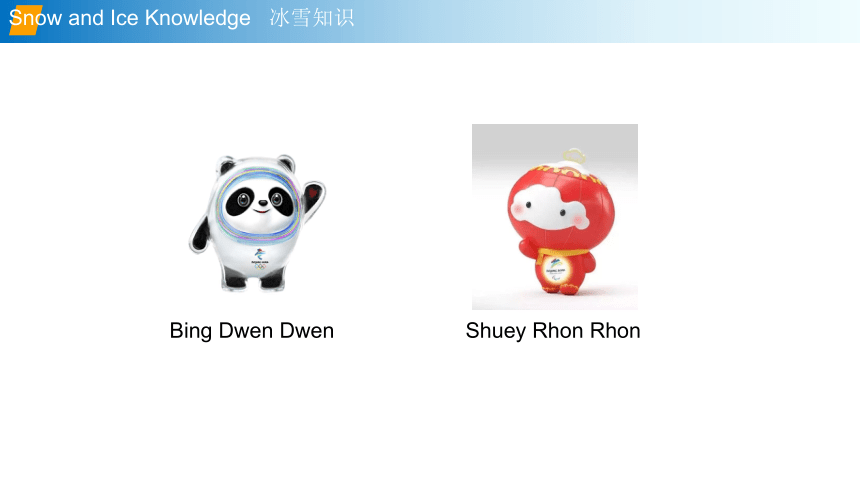
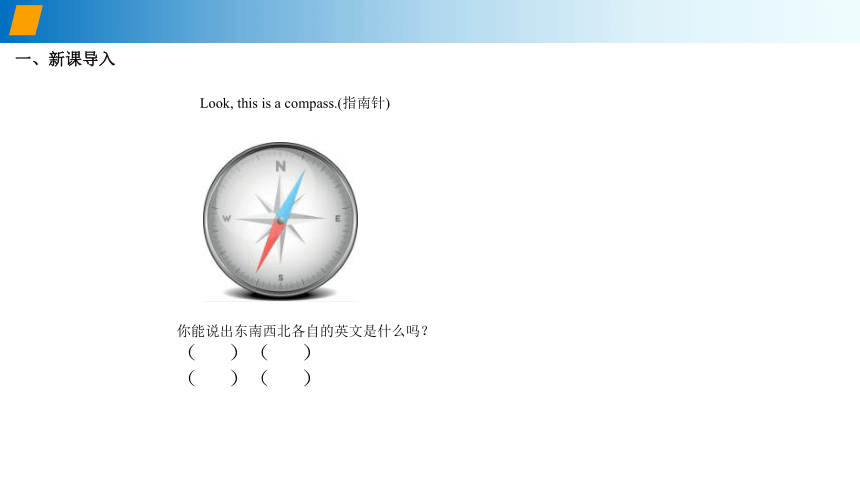
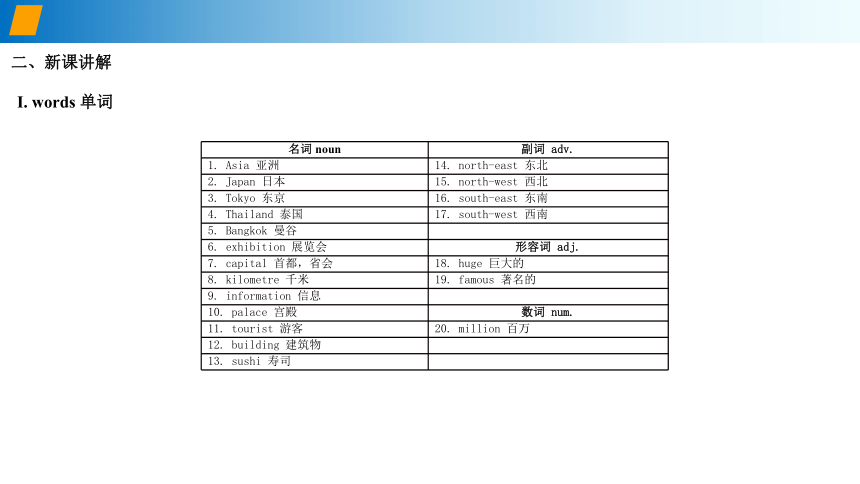
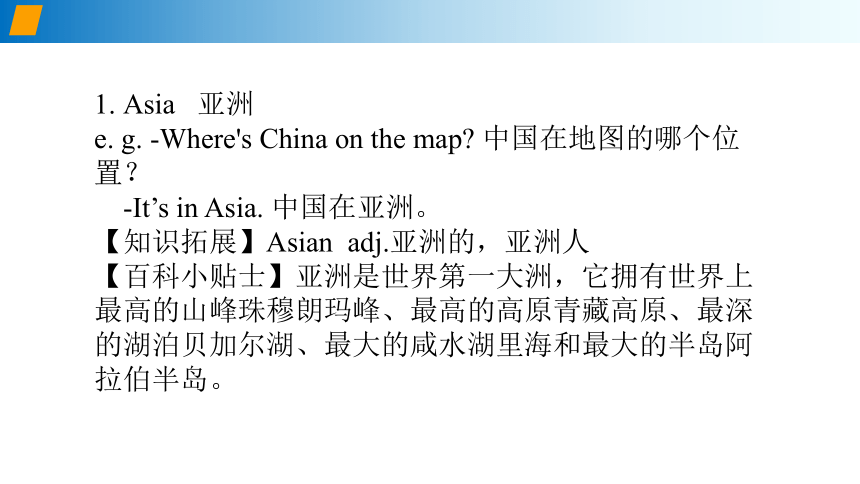

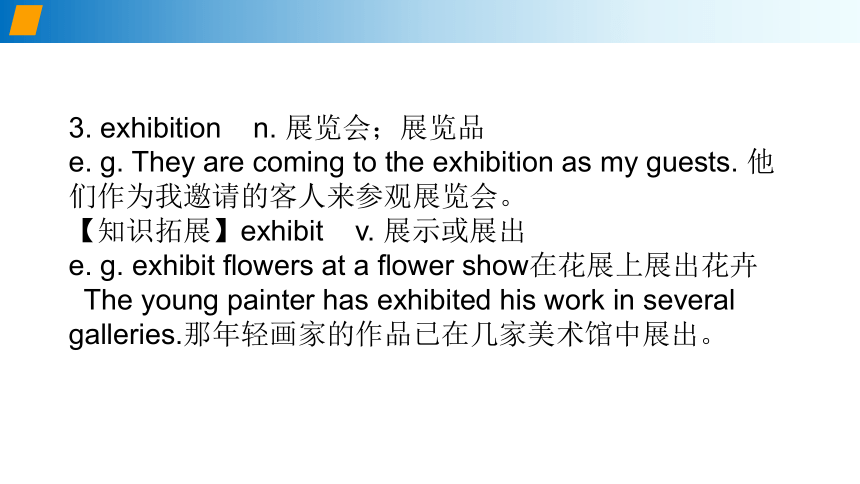
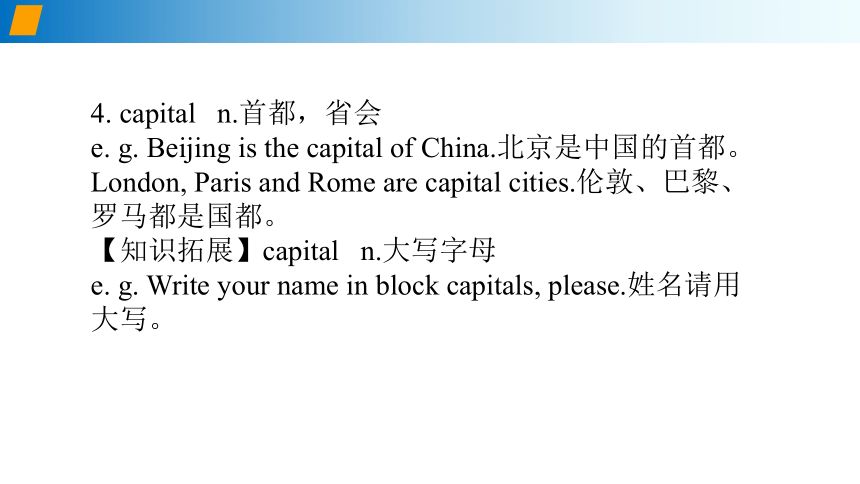
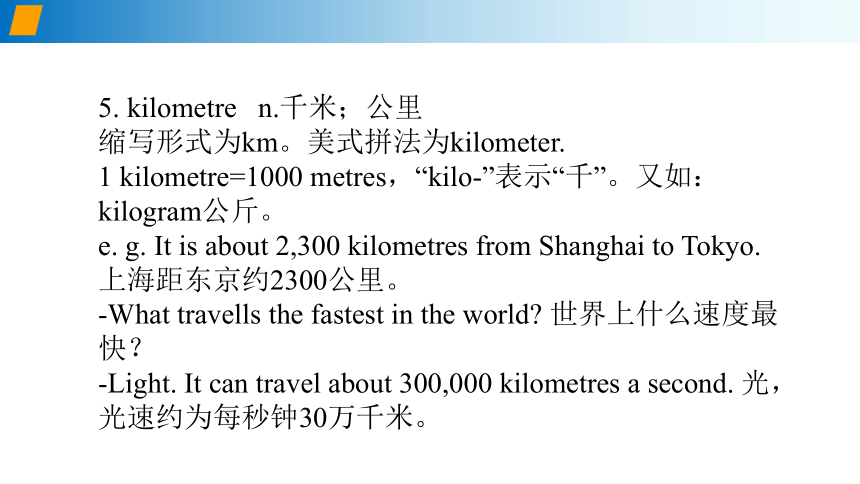
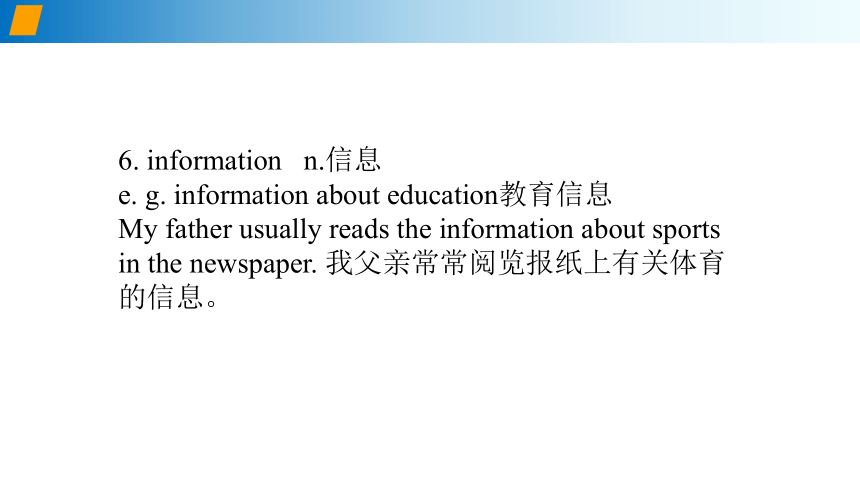
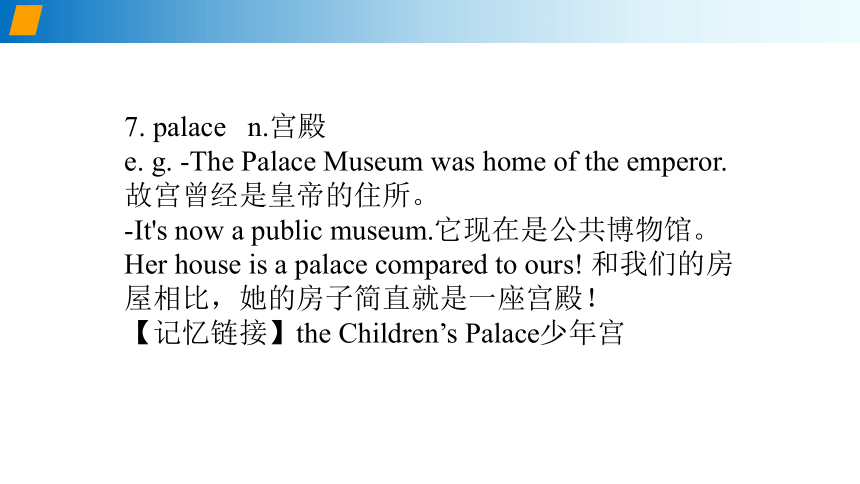
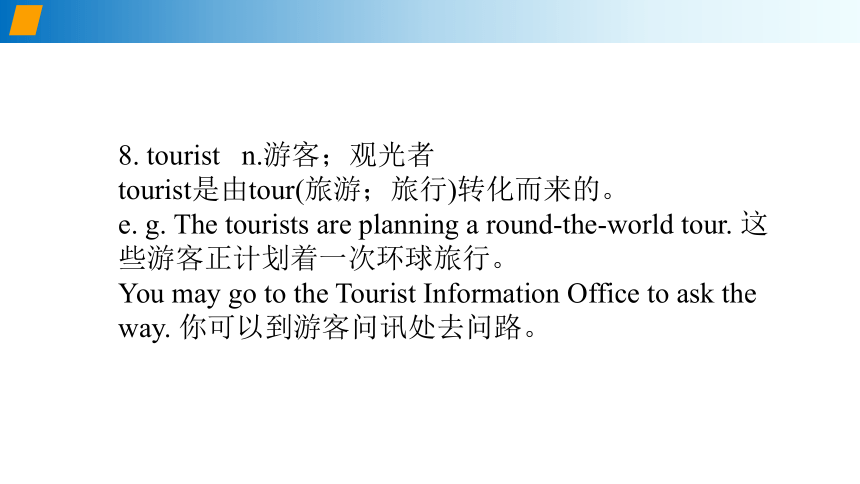
文档简介
(共34张PPT)
Lead in— 脑筋急转弯
Q:四个人在一间小屋里打麻将(没有其他人在看着),这时警察来了,四个人都跑了,可是警察到了屋里又抓到一个人,为什么?
A:四个人在屋里打一个叫“麻将”的人,警察抓到的是他
沪教版 英语 六年级 第二学期
Snow and Ice Knowledge 冰雪知识
Bing Dwen Dwen
Shuey Rhon Rhon
一、新课导入
Look, this is a compass.(指南针)
你能说出东南西北各自的英文是什么吗?
( )( )
( )( )
二、新课讲解
名词 noun 副词 adv.
1. Asia 亚洲 14. north-east 东北
2. Japan 日本 15. north-west 西北
3. Tokyo 东京 16. south-east 东南
4. Thailand 泰国 17. south-west 西南
5. Bangkok 曼谷
6. exhibition 展览会 形容词 adj.
7. capital 首都,省会 18. huge 巨大的
8. kilometre 千米 19. famous 著名的
9. information 信息
10. palace 宫殿 数词 num.
11. tourist 游客 20. million 百万
12. building 建筑物
13. sushi 寿司
Ⅰ. words 单词
1. Asia 亚洲
e. g. -Where's China on the map 中国在地图的哪个位置?
-It’s in Asia. 中国在亚洲。
【知识拓展】Asian adj.亚洲的,亚洲人
【百科小贴士】亚洲是世界第一大洲,它拥有世界上最高的山峰珠穆朗玛峰、最高的高原青藏高原、最深的湖泊贝加尔湖、最大的咸水湖里海和最大的半岛阿拉伯半岛。
2. east (E) adv.在东方
e. g. Tokyo is east of Beijing.东京在北京的东方。
【友情提示】E为east的缩写。又如south(S)在南方,west( W)在西方,north( N)在北方,north-east(NE)在东北方。注意中英文在表达方位时的差异:汉语说“东北”,但英语说north-east。又如north-west(NW)在西北方,south-east( SE)在东南方,south-west( SW)在西南方。用英语表达方位时,我们可以这样记忆:“南北在前,短横在中,东西在后”。
e. g. Bangkok is south-west of Shanghai.曼谷在上海的西南方。
注:North China: 华北
3. exhibition n. 展览会;展览品
e. g. They are coming to the exhibition as my guests. 他们作为我邀请的客人来参观展览会。
【知识拓展】exhibit v. 展示或展出
e. g. exhibit flowers at a flower show在花展上展出花卉
The young painter has exhibited his work in several galleries.那年轻画家的作品已在几家美术馆中展出。
4. capital n.首都,省会
e. g. Beijing is the capital of China.北京是中国的首都。
London, Paris and Rome are capital cities.伦敦、巴黎、罗马都是国都。
【知识拓展】capital n.大写字母
e. g. Write your name in block capitals, please.姓名请用大写。
5. kilometre n.千米;公里
缩写形式为km。美式拼法为kilometer.
1 kilometre=1000 metres,“kilo-”表示“千”。又如:kilogram公斤。
e. g. It is about 2,300 kilometres from Shanghai to Tokyo.上海距东京约2300公里。
-What travells the fastest in the world 世界上什么速度最快?
-Light. It can travel about 300,000 kilometres a second. 光,光速约为每秒钟30万千米。
6. information n.信息
e. g. information about education教育信息
My father usually reads the information about sports in the newspaper. 我父亲常常阅览报纸上有关体育的信息。
7. palace n.宫殿
e. g. -The Palace Museum was home of the emperor.故宫曾经是皇帝的住所。
-It's now a public museum.它现在是公共博物馆。
Her house is a palace compared to ours! 和我们的房屋相比,她的房子简直就是一座宫殿!
【记忆链接】the Children’s Palace少年宫
8. tourist n.游客;观光者
tourist是由tour(旅游;旅行)转化而来的。
e. g. The tourists are planning a round-the-world tour. 这些游客正计划着一次环球旅行。
You may go to the Tourist Information Office to ask the way. 你可以到游客问讯处去问路。
9. million num.百万
e. g. The Sun is about ninety-three million miles away from us. 太阳距离我们大约有9300万英里远。
【知识拓展】hundred,thousand,million三个数词的用法
(1)这三个数词在表达具体数字的时候没有复数形式。
e. g. three hundred三百 five thousand五千
(2)这三个数词在与of连用表示成百成千时一定要用复数形式。
e. g. millions of 成百万的
10. building n.建筑物
e. g. -This is our new building.这是我们的新教学楼。
-It's beautiful!真漂亮!
【知识拓展】build v.建造
e. g. -What's the mother bird doing 鸟妈妈在干吗?
-She's building a nest for her babies.她在为小鸟们搭窝。
11. huge adj.巨大的
e. g. -What a huge plane! 这架飞机真大呀!
-It can take 500 passengers.它能载500名乘客呢。
The TV play was a huge success.这部电视剧取得了巨大的成功。
【知识拓展】small adj.小的 tiny adj.微小的
12. famous adj.著名的
e. g. -Who is the most famous monkey in China 中国最著名的猴子是哪个?
-It's Monkey King Sun Wukong! 是猴王孙悟空呀!
-What is the most famous food in Beijing 北京最有名的食物是什么?
-Of course, Beijing Duck.当然是北京烤鸭了。
【指点迷津】be famous for,be famous as的区别
(l)be famous for除指某人的某种知识、技能或特征而出名(原因)以外,亦可以指以某种特产出名(for后的宾语是主语的所属)。
e. g. Tai'an is famous for Mount Tai.泰安因泰山而闻名。
(2) be famous as指某人以某种身份而出名(结果),或以产地或地名而出名(as后的宾语是主语的同位语)。
e. g. Chenglong is famous as an actor.成龙是一位著名演员。
Hangzhou is famous as a green tea producing place.杭州是绿茶的盛产地。
Daily expressions. 日常表达
1. by plane乘飞机
“by+交通工具’’表示‘‘乘……(交通工具)”。
注意在此结构中,交通工具前不加冠词a/an或the。
e. g. by bus/train/ship/underground乘公共汽车/火车/船/地铁
【友情提示】课文中的by plane相当于by air, by ship相当于by sea。表示步行可用on foot。询问“乘……(交通工具)”,用How进行提问。
e. g. - How do you and Peter go to school every day 你和彼得每天是怎么去上学的?
-I go to school on foot and he goes there by underground. 我步行去上学,他坐地铁去。
2. two and a half days两天半
two and a half days=two days and a half,其中two and a half days中的half为形容词,意为“一半的”,two days and a half中的half为名词,意为“一半”。
e. g. one and a half hours=one hour and a half一个半小时
3. in the past在过去;从前
e. g. - In the past, it took many days to send a letter. 过去寄一封信要好多天。
-Yes. But it takes only a few seconds now by e-mail. 是呀,现在用电子邮件,几秒钟就好了。
4. the Great Wall长城
它是专有名词,首字母要大写。专有名词表示具体的人、事物、专有机构或团体的名称。
e. g. Kate凯特(人名) Japanese日本(地名) New York纽约(地名)
5. more than多于;超过
e. g. There are more than 20 students in our class.我们班有20多个人。
This skirt costs more than that one.这条裙子比那条贵。
6. enjoy doing sth喜欢做某事
enjoy(喜欢,享受)后面往往跟名词,代词以及动词的-ing形式。
e. g. Some people enjoy tea, while others enjoy coffee. 一些人喜欢喝茶,而一些人喜欢喝咖啡。
Tom and Jerry enjoy living in the countryside.汤姆和杰瑞喜欢住在乡间。
【友情提示】like,love和enjoy有同样的用法:like/love doing sth.喜欢做某事
e. g. Kitty likes/enjoys/loves eating tomato noodles.凯蒂喜欢吃西红柿面。
My grandfather likes/enjoys/loves doing exercice in the morning.我爷爷喜欢做晨练。
【知识拓展】动名词的使用
(1)英语中动词加上-ing可以构成一个动名词。动名词有名词的特性,可以作为某些动词的宾语。如like eating,eat本身是动词,加上-ing后就成了动名词,是like的宾语。
(2)动名词的构成一般是动词直接加上-ing,但要注意以下情况:
①以重读闭音节结尾的单词,要双写最后一个字母再加-ing,如swim-swimming,shop- shopping。
②末尾字母为e的单词,要省略e再加-ing,如ride+riding。
③末尾为ie的单词,ie要改为y再加-ing,如lie+lying。
(3)有些动词后面只能用动名词作宾语,如enjoy:有的既可以用动名词作宾语也可以用不定式作宾语,如like eating/to eat。
Fill in the blanks with the proper forms of the given words.
1. We are going to visit some big ____________ in Asia. (city)
2. I like to go _____________ with my mother. (shop)
3. A lot of _____________ come to Shanghai every year. (tour)
4. Beijing is the capital of ______________.(Chinese)
5. You can see a lot of tall ____________ in Shanghai. (build)
随堂练习一
【Keys】1. cities 2. shopping 3. tourists 4. China 5. buildings
Important Sentences structures
1. Which city is the capital of…?
此句用于询问“……(城市)是……(国家的)首都”。Which意为“哪个”,用来询问具体事物。
e. g. -Which city is the capital of China 哪个城市是中国的首都?
-Beijing is the capital of China.北京是中国的首都。
2. A在B的某方向的表达
(1)若A、B两个地方不相连,常用如下表达方式:
Tokyo is east of Beijing.或:Tokyo is to the east of Beijing.东京在北京的东方。
(2)若A、B两个地方相毗邻,则表达方式如下:
Jiangsu is on the north of Shanghai.江苏在上海的北方。
(3)若A、B两个地方是从属关系.则表达方式如下;
Shanghai is in the east of China.上海位于中国的东部。
3. How far is it from…to…?
用于询问“从……(一个地方)到……(另一个地方)有多远?”。
How far表示“有多远”,用于询问距离。
e. g. -How far is it from Shanghai to Suzhou 上海到苏州有多远?
-It's about 96 kilometres.大约96公里。
4. How long does it take from…to…?
用于询问“从……(一个地方)到……(另一个地方)需多少时间?” How long表示“多久,多长(时间)”,用于对一段时间的提问。回答时用句型“It takes somebody…(time) to do…”,意为“某人做……(事)需要花费……(时间)”。这里的“某人”,若使用人称代词,需用其宾格。
e. g. -How long does it take to travel from your home to school by bike 从你家骑车到学校要多少时间?
-It takes me about fifteen minutes.我大约花15分钟。
Fill in the blanks with the given words in their proper forms.
1. Some people learn as their second language. (Japan)
2. Many go to Thailand to enjoy the sunshine. (tour)
3. Shanghai is one of the biggest in the world. (city)
4. You can see a lot of tall in Tokyo. (build)
5. People in Bangkok love food. (spice)
随堂练习二
Rewrite the sentence as required.
1. People always visit the Great Wall. (改成一般疑问句)
___________people always the Great Wall
2. Grandparents live in Pink Garden Estate. (改成否定句)
Grandparents____________ ___________ in Pink Garden Estate.
3. In the past, people took a ship to other places. (保持句意不变)
In the past, people____________ ___________ other places by ship.
4. The watch cost him 100 yuan. (保持句意不变)
____________ ____________ did the watch cost him
5. It's about 10 minutes walk from here to the bus station. (对划线部分提问)
____________ ____________ is it from here to the bus station
6. There are 12 million people in Tokyo. (对划线部分提问)
____________ ____________ people are there in Tokyo
7. Kitty washes the dishes every day. (用 Yesterday 代替 every day)
Kitty the dishes .
【Keys】1. Japanese 2. tourists 3. cities 4. buildings 5. spicy
【Keys】1. Do... visit 2. don't live 3. traveled to / went to
4. How much 5. How far 6. How many 7. washed... yesterday
愿君皆有所获,皆有所得
Lead in— 脑筋急转弯
Q:四个人在一间小屋里打麻将(没有其他人在看着),这时警察来了,四个人都跑了,可是警察到了屋里又抓到一个人,为什么?
A:四个人在屋里打一个叫“麻将”的人,警察抓到的是他
沪教版 英语 六年级 第二学期
Snow and Ice Knowledge 冰雪知识
Bing Dwen Dwen
Shuey Rhon Rhon
一、新课导入
Look, this is a compass.(指南针)
你能说出东南西北各自的英文是什么吗?
( )( )
( )( )
二、新课讲解
名词 noun 副词 adv.
1. Asia 亚洲 14. north-east 东北
2. Japan 日本 15. north-west 西北
3. Tokyo 东京 16. south-east 东南
4. Thailand 泰国 17. south-west 西南
5. Bangkok 曼谷
6. exhibition 展览会 形容词 adj.
7. capital 首都,省会 18. huge 巨大的
8. kilometre 千米 19. famous 著名的
9. information 信息
10. palace 宫殿 数词 num.
11. tourist 游客 20. million 百万
12. building 建筑物
13. sushi 寿司
Ⅰ. words 单词
1. Asia 亚洲
e. g. -Where's China on the map 中国在地图的哪个位置?
-It’s in Asia. 中国在亚洲。
【知识拓展】Asian adj.亚洲的,亚洲人
【百科小贴士】亚洲是世界第一大洲,它拥有世界上最高的山峰珠穆朗玛峰、最高的高原青藏高原、最深的湖泊贝加尔湖、最大的咸水湖里海和最大的半岛阿拉伯半岛。
2. east (E) adv.在东方
e. g. Tokyo is east of Beijing.东京在北京的东方。
【友情提示】E为east的缩写。又如south(S)在南方,west( W)在西方,north( N)在北方,north-east(NE)在东北方。注意中英文在表达方位时的差异:汉语说“东北”,但英语说north-east。又如north-west(NW)在西北方,south-east( SE)在东南方,south-west( SW)在西南方。用英语表达方位时,我们可以这样记忆:“南北在前,短横在中,东西在后”。
e. g. Bangkok is south-west of Shanghai.曼谷在上海的西南方。
注:North China: 华北
3. exhibition n. 展览会;展览品
e. g. They are coming to the exhibition as my guests. 他们作为我邀请的客人来参观展览会。
【知识拓展】exhibit v. 展示或展出
e. g. exhibit flowers at a flower show在花展上展出花卉
The young painter has exhibited his work in several galleries.那年轻画家的作品已在几家美术馆中展出。
4. capital n.首都,省会
e. g. Beijing is the capital of China.北京是中国的首都。
London, Paris and Rome are capital cities.伦敦、巴黎、罗马都是国都。
【知识拓展】capital n.大写字母
e. g. Write your name in block capitals, please.姓名请用大写。
5. kilometre n.千米;公里
缩写形式为km。美式拼法为kilometer.
1 kilometre=1000 metres,“kilo-”表示“千”。又如:kilogram公斤。
e. g. It is about 2,300 kilometres from Shanghai to Tokyo.上海距东京约2300公里。
-What travells the fastest in the world 世界上什么速度最快?
-Light. It can travel about 300,000 kilometres a second. 光,光速约为每秒钟30万千米。
6. information n.信息
e. g. information about education教育信息
My father usually reads the information about sports in the newspaper. 我父亲常常阅览报纸上有关体育的信息。
7. palace n.宫殿
e. g. -The Palace Museum was home of the emperor.故宫曾经是皇帝的住所。
-It's now a public museum.它现在是公共博物馆。
Her house is a palace compared to ours! 和我们的房屋相比,她的房子简直就是一座宫殿!
【记忆链接】the Children’s Palace少年宫
8. tourist n.游客;观光者
tourist是由tour(旅游;旅行)转化而来的。
e. g. The tourists are planning a round-the-world tour. 这些游客正计划着一次环球旅行。
You may go to the Tourist Information Office to ask the way. 你可以到游客问讯处去问路。
9. million num.百万
e. g. The Sun is about ninety-three million miles away from us. 太阳距离我们大约有9300万英里远。
【知识拓展】hundred,thousand,million三个数词的用法
(1)这三个数词在表达具体数字的时候没有复数形式。
e. g. three hundred三百 five thousand五千
(2)这三个数词在与of连用表示成百成千时一定要用复数形式。
e. g. millions of 成百万的
10. building n.建筑物
e. g. -This is our new building.这是我们的新教学楼。
-It's beautiful!真漂亮!
【知识拓展】build v.建造
e. g. -What's the mother bird doing 鸟妈妈在干吗?
-She's building a nest for her babies.她在为小鸟们搭窝。
11. huge adj.巨大的
e. g. -What a huge plane! 这架飞机真大呀!
-It can take 500 passengers.它能载500名乘客呢。
The TV play was a huge success.这部电视剧取得了巨大的成功。
【知识拓展】small adj.小的 tiny adj.微小的
12. famous adj.著名的
e. g. -Who is the most famous monkey in China 中国最著名的猴子是哪个?
-It's Monkey King Sun Wukong! 是猴王孙悟空呀!
-What is the most famous food in Beijing 北京最有名的食物是什么?
-Of course, Beijing Duck.当然是北京烤鸭了。
【指点迷津】be famous for,be famous as的区别
(l)be famous for除指某人的某种知识、技能或特征而出名(原因)以外,亦可以指以某种特产出名(for后的宾语是主语的所属)。
e. g. Tai'an is famous for Mount Tai.泰安因泰山而闻名。
(2) be famous as指某人以某种身份而出名(结果),或以产地或地名而出名(as后的宾语是主语的同位语)。
e. g. Chenglong is famous as an actor.成龙是一位著名演员。
Hangzhou is famous as a green tea producing place.杭州是绿茶的盛产地。
Daily expressions. 日常表达
1. by plane乘飞机
“by+交通工具’’表示‘‘乘……(交通工具)”。
注意在此结构中,交通工具前不加冠词a/an或the。
e. g. by bus/train/ship/underground乘公共汽车/火车/船/地铁
【友情提示】课文中的by plane相当于by air, by ship相当于by sea。表示步行可用on foot。询问“乘……(交通工具)”,用How进行提问。
e. g. - How do you and Peter go to school every day 你和彼得每天是怎么去上学的?
-I go to school on foot and he goes there by underground. 我步行去上学,他坐地铁去。
2. two and a half days两天半
two and a half days=two days and a half,其中two and a half days中的half为形容词,意为“一半的”,two days and a half中的half为名词,意为“一半”。
e. g. one and a half hours=one hour and a half一个半小时
3. in the past在过去;从前
e. g. - In the past, it took many days to send a letter. 过去寄一封信要好多天。
-Yes. But it takes only a few seconds now by e-mail. 是呀,现在用电子邮件,几秒钟就好了。
4. the Great Wall长城
它是专有名词,首字母要大写。专有名词表示具体的人、事物、专有机构或团体的名称。
e. g. Kate凯特(人名) Japanese日本(地名) New York纽约(地名)
5. more than多于;超过
e. g. There are more than 20 students in our class.我们班有20多个人。
This skirt costs more than that one.这条裙子比那条贵。
6. enjoy doing sth喜欢做某事
enjoy(喜欢,享受)后面往往跟名词,代词以及动词的-ing形式。
e. g. Some people enjoy tea, while others enjoy coffee. 一些人喜欢喝茶,而一些人喜欢喝咖啡。
Tom and Jerry enjoy living in the countryside.汤姆和杰瑞喜欢住在乡间。
【友情提示】like,love和enjoy有同样的用法:like/love doing sth.喜欢做某事
e. g. Kitty likes/enjoys/loves eating tomato noodles.凯蒂喜欢吃西红柿面。
My grandfather likes/enjoys/loves doing exercice in the morning.我爷爷喜欢做晨练。
【知识拓展】动名词的使用
(1)英语中动词加上-ing可以构成一个动名词。动名词有名词的特性,可以作为某些动词的宾语。如like eating,eat本身是动词,加上-ing后就成了动名词,是like的宾语。
(2)动名词的构成一般是动词直接加上-ing,但要注意以下情况:
①以重读闭音节结尾的单词,要双写最后一个字母再加-ing,如swim-swimming,shop- shopping。
②末尾字母为e的单词,要省略e再加-ing,如ride+riding。
③末尾为ie的单词,ie要改为y再加-ing,如lie+lying。
(3)有些动词后面只能用动名词作宾语,如enjoy:有的既可以用动名词作宾语也可以用不定式作宾语,如like eating/to eat。
Fill in the blanks with the proper forms of the given words.
1. We are going to visit some big ____________ in Asia. (city)
2. I like to go _____________ with my mother. (shop)
3. A lot of _____________ come to Shanghai every year. (tour)
4. Beijing is the capital of ______________.(Chinese)
5. You can see a lot of tall ____________ in Shanghai. (build)
随堂练习一
【Keys】1. cities 2. shopping 3. tourists 4. China 5. buildings
Important Sentences structures
1. Which city is the capital of…?
此句用于询问“……(城市)是……(国家的)首都”。Which意为“哪个”,用来询问具体事物。
e. g. -Which city is the capital of China 哪个城市是中国的首都?
-Beijing is the capital of China.北京是中国的首都。
2. A在B的某方向的表达
(1)若A、B两个地方不相连,常用如下表达方式:
Tokyo is east of Beijing.或:Tokyo is to the east of Beijing.东京在北京的东方。
(2)若A、B两个地方相毗邻,则表达方式如下:
Jiangsu is on the north of Shanghai.江苏在上海的北方。
(3)若A、B两个地方是从属关系.则表达方式如下;
Shanghai is in the east of China.上海位于中国的东部。
3. How far is it from…to…?
用于询问“从……(一个地方)到……(另一个地方)有多远?”。
How far表示“有多远”,用于询问距离。
e. g. -How far is it from Shanghai to Suzhou 上海到苏州有多远?
-It's about 96 kilometres.大约96公里。
4. How long does it take from…to…?
用于询问“从……(一个地方)到……(另一个地方)需多少时间?” How long表示“多久,多长(时间)”,用于对一段时间的提问。回答时用句型“It takes somebody…(time) to do…”,意为“某人做……(事)需要花费……(时间)”。这里的“某人”,若使用人称代词,需用其宾格。
e. g. -How long does it take to travel from your home to school by bike 从你家骑车到学校要多少时间?
-It takes me about fifteen minutes.我大约花15分钟。
Fill in the blanks with the given words in their proper forms.
1. Some people learn as their second language. (Japan)
2. Many go to Thailand to enjoy the sunshine. (tour)
3. Shanghai is one of the biggest in the world. (city)
4. You can see a lot of tall in Tokyo. (build)
5. People in Bangkok love food. (spice)
随堂练习二
Rewrite the sentence as required.
1. People always visit the Great Wall. (改成一般疑问句)
___________people always the Great Wall
2. Grandparents live in Pink Garden Estate. (改成否定句)
Grandparents____________ ___________ in Pink Garden Estate.
3. In the past, people took a ship to other places. (保持句意不变)
In the past, people____________ ___________ other places by ship.
4. The watch cost him 100 yuan. (保持句意不变)
____________ ____________ did the watch cost him
5. It's about 10 minutes walk from here to the bus station. (对划线部分提问)
____________ ____________ is it from here to the bus station
6. There are 12 million people in Tokyo. (对划线部分提问)
____________ ____________ people are there in Tokyo
7. Kitty washes the dishes every day. (用 Yesterday 代替 every day)
Kitty the dishes .
【Keys】1. Japanese 2. tourists 3. cities 4. buildings 5. spicy
【Keys】1. Do... visit 2. don't live 3. traveled to / went to
4. How much 5. How far 6. How many 7. washed... yesterday
愿君皆有所获,皆有所得
同课章节目录
- Module 1 City life
- Unit 1 Great cities in Asia
- Unit 2 At the airport
- Unit 3 Dragon Boat Festival
- Unit 4 Staying healthy
- Module 2 Changes
- Unit 5 What will I be like?
- Unit 6 Seasonal changes
- Unit 7 Travelling in Garden City
- Module 3 The nature world
- Unit 8 Windy weathe
- Unit 9 Sea water and rain wate
- Unit 10 Forests and land
- Unit 11 Controlling fire
